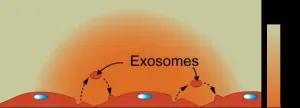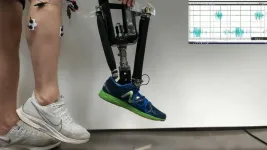(Press-News.org) Images // Video
Taking inspiration from music streaming services, a team of engineers at the University of Michigan, Google and Georgia Tech has designed the simplest way for users to program their own exoskeleton assistance settings.
Of course, what's simple for the users is more complex underneath, as a machine learning algorithm repeatedly offers pairs of assistance profiles that are most likely to be comfortable for the wearer. The user then selects one of these two, and the predictor offers another assistance profile that it believes might be better. This approach enables users to set the exoskeleton assistance based on their preferences using a very simple interface, conducive to implementing on a smartwatch or phone.
"It's essentially like Pandora music," said Elliott Rouse, U-M associate professor of robotics and mechanical engineering and corresponding author of the study in Science Robotics. "You give it feedback, a thumbs up or thumbs down, and it curates a radio station based on your feedback. This is a similar idea, but it's with exoskeleton assistance settings. In both cases, we are creating a model of the user's preferences and using this model to optimize the user's experience."
The team tested the approach with 14 participants, each wearing a pair of ankle exoskeletons as they walked at a steady pace of about 2.3 miles per hour. The volunteers could take as much time as they wanted between choices, although they were limited to 50 choices. Most participants were choosing the same assistance profile repeatedly by the 45th decision.
After 50 rounds, the experimental team began testing the users to see whether the final assistance profile was truly the best—pairing it against 10 randomly generated (but plausible) profiles. On average, participants chose the settings suggested by the algorithm about nine out of 10 times, which highlights the accuracy of the proposed approach.
"By using clever algorithms and a touch of AI, our system figures out what users want with easy yes-or-no questions," said Ung Hee Lee, a recent U-M doctoral graduate from mechanical engineering and first author of the study, now at the robotics company Nuro. "I'm excited that this approach will make wearable robots comfortable and easy to use, bringing them closer to becoming a normal part of our day-to-day life."
The control algorithm manages four exoskeleton settings: how much assistance to give (peak torque), how long to go between peaks (timing), and how the exoskeleton both ramps up and reduces the assistance on either side of each peak. This assistance approach is based on how our calf muscle adds force to propel us forward in each step.
Rouse reports that few groups are enabling users to set their own exoskeleton settings.
"In most cases, controllers are tuned based on biomechanical or physiological results. The researchers are adjusting the settings on their laptops, minimizing the user's metabolic rate. Right now, that's the gold standard for exoskeleton assessment and control," Rouse said.
"I think our field overemphasizes testing with metabolic rate. People are actually very insensitive to changes in their own metabolic rate, so we're developing exoskeletons to do something that people can't actually perceive."
In contrast, user preference approaches not only focus on what users can perceive but also enable them to prioritize qualities that they feel are valuable.
The study builds on the team's previous effort to enable users to apply their own settings to an ankle exoskeleton. In that study, users had a touchscreen grid that put the level of assistance on one axis and the timing of the assistance on another. Users tried different points on the grid until they found one that worked well for them.
Once users had discovered what was comfortable, over the course of a couple of hours, they were then able to find their settings on the grid within a couple of minutes. The new study cuts down that longer period of discovering which settings feel best as well as offering two new parameters: how the assistance ramps up and down.
The data from that earlier study were used to feed the machine learning predictor. An evolutionary algorithm produces variations based on the assistance profiles that those earlier users preferred, and then the predictor—a neural network—ranked those assistance profiles. With each choice the users made, new potential assistance profiles were generated, ranked and presented to the user alongside their previous choice.
The study was funded by X, Google's "Moonshot Factory," Robotics at Google (now Google Deepmind), and the D. Dan and Betty Kahn Foundation. The concept is currently licensed by Alphabet spinoff Skip Innovations.
Study: User preference optimization for control of ankle exoskeletons using sample efficient active learning (DOI: 10.1126/scirobotics.adg3705)
END
Choosing exoskeleton settings like a Pandora radio station
Using a simple and convenient touchscreen interface, the algorithm learns the assistance preferences of the wearer
2023-10-18
ELSE PRESS RELEASES FROM THIS DATE:
School discipline referrals for substance use increased in Oregon middle schools after legalization of recreational marijuana
2023-10-18
School Discipline Referrals for Substance Use Increased in Oregon Middle Schools after Legalization of Recreational Marijuana
A recent study found that Oregon middle school students received office discipline referrals (ODRs) for substance use offenses 30% more often after legalization of recreational marijuana relative to comparison schools in other states over the same period (school years 2012/2013 – 2018/2019). There were no statistically discernable changes in high school ODRs. Recreational use by adults was legalized in Oregon in 2015.
Researchers examined the extent to which legalization of recreational marijuana ...
UMass Amherst engineering professor is awarded $1.9 million to push the bounds of cancer, heart disease research
2023-10-18
UMass Amherst Engineering Professor Is Awarded $1.9 Million to Push the Bounds of Cancer, Heart Disease Research
Jinglei Ping will explore a new method of controlling cell communication by electronically regulating exosome traffic through the National Institutes of Health grant
AMHERST, Mass. — The human body is a sophisticated organism that has complex internal communication systems down to a cellular level. However, these systems transmit more than just messages about healthy human functions; they can also influence disease.
Consider cancer. Jinglei Ping poses the question: “How do unhealthy cells transport their own cancer ...
American Society of Anesthesiologists names Ronald L. Harter, M.D., FASA, new president
2023-10-18
SAN FRANCISCO — Ronald L. Harter, M.D., FASA, professor of anesthesiology in the Department of Anesthesiology at The Ohio State University Wexner Medical Center in Columbus, was today named president of the American Society of Anesthesiologists (ASA), the nation’s largest organization of physician anesthesiologists. Dr. Harter assumed office at the ANESTHESIOLOGY® 2023 annual meeting and will serve for one year.
“ASA is the premier educational, research and scientific organization representing anesthesiology in the U.S., and I’m honored to have this opportunity to advance ...
Study finds increased risk of Guillain-Barré after COVID-19 infection
2023-10-18
EMBARGOED FOR RELEASE UNTIL 4 P.M. ET, WEDNESDAY, OCTOBER 18, 2023
MINNEAPOLIS – Having a COVID-19 infection is associated with an increased risk of developing the rare disorder called Guillain-Barré syndrome within the next six weeks, according to a study published in the October 18, 2023, online issue of Neurology®, the medical journal of the American Academy of Neurology. The study also found that people who received the mRNA vaccine from Pfizer-BioNTech were less likely to develop the ...
Protecting polar bears aim of new and improved radar technology
2023-10-18
Research testing new technology to more effectively locate polar bear dens across the Arctic is showing promising results. Researchers from Simon Fraser University and Brigham Young University (BYU), collaborating with Polar Bears International, hope that improving detection tools to locate dens—which are nearly invisible and buried under snow—will help efforts to protect mother polar bears and their cubs.
Results of a pilot study aimed at improving den location in Churchill, Manitoba—using ARTEMIS Inc., an imaging system that relies on Synthetic Aperture Radar, or SAR—are published this week ...
From one nightmare to another. Anthony Fauci’s new concern
2023-10-18
(WASHINGTON) -- “What keeps you up at night?”
It’s a question Anthony Fauci, MD, heard repeatedly over the course of his nearly four decades as director of the National Institute of Allergy and Infectious Diseases at the National Institutes of Health.
Now a Distinguished University Professor at Georgetown University School of Medicine and the McCourt School of Public Policy, Fauci says he realized his worst nightmare -- a twist on the usual question -- in January 2020 when the type of virus he most feared triggered a worldwide pandemic.
Today, as the COVID-19 pandemic wanes, Fauci describes a new nemesis ...
Robotic prosthetic ankles improve ‘natural’ movement, stability
2023-10-18
Robotic prosthetic ankles that are controlled by nerve impulses allow amputees to move more “naturally,” improving their stability, according to a new study from North Carolina State University and the University of North Carolina at Chapel Hill.
“This work focused on ‘postural control,’ which is surprisingly complicated,” says Helen Huang, corresponding author of the study and the Jackson Family Distinguished Professor in the Joint Department of Biomedical Engineering at NC State and UNC.
“Basically, when we are standing still, ...
New study suggests promising approach for treating pancreatic cancer
2023-10-18
A new study carried out in mice, led by Queen Mary University of London, has identified cells that drive the spread of pancreatic cancer and discovered a weakness in these cells that could be targeted using existing drugs. This offers a promising new approach for treating pancreatic cancer.
The research, published in Science Advances and funded by Barts Charity and Cancer Research UK, found that many patients' pancreatic cancer contains cells called amoeboid cells. These are aggressive, invasive ...
The encounter between Neanderthals and Sapiens as told by their genomes
2023-10-18
About 40,000 years ago, Neanderthals, who had lived for hundreds of thousands of years in the western part of the Eurasian continent, gave way to Homo sapiens, who had arrived from Africa. This replacement was not sudden, and the two species coexisted for a few millennia, resulting in the integration of Neanderthal DNA into the genome of Sapiens. Researchers at the University of Geneva (UNIGE) have analyzed the distribution of the portion of DNA inherited from Neanderthals in the genomes of humans (Homo sapiens) ...
Migrants in Denmark face disparities in care for type 2 diabetes
2023-10-18
A large, population-wide study of Denmark residents with type 2 diabetes shows that migrants typically face a greater risk of inferior care for their disease than native Danes, particularly when it comes to monitoring their disease and controlling biomarkers—managing blood levels of key substances that are associated with diabetes. Anders Aasted Isaksen of Aarhus University and Steno Diabetes Center Aarhus, Denmark, and colleagues present these findings in the open-access journal PLOS Global Public Health.
Prior research ...
LAST 30 PRESS RELEASES:
Revealing the diversity of olfactory receptors in hagfish and its implications for early vertebrate evolution
Development of an ultrasonic sensor capable of cuffless, non-invasive blood pressure measurement
Longer treatment with medications for opioid use disorder is associated with greater probability of survival
Strategy over morality can help conservation campaigns reduce ivory demand, research shows
Rising temperatures reshape microbial carbon cycling during animal carcass decomposition in water
Achieving ultra-low-power explosive jumps via locust bio-hybrid muscle actuators
Plant-derived phenolic acids revive the power of tetracycline against drug-resistant bacteria
Cooperation: A costly affair in bacterial social behaviour?
Viruses in wastewater: Silent drivers of pollution removal and antibiotic resistance
Sub-iethal water disinfection may accelerate the spread of antibiotic resistance
Three in four new Australian moms struggle with body image
Post-stroke injection protects the brain in preclinical study
Cardiovascular risk score predicts multiple eye diseases
Health: estimated one in ten British adults used or interested in GLP-1 medications for weight loss
Exercise to treat depression yields similar results to therapy
Whooping cough vaccination for pregnant women strengthens babies’ immune system
Dramatic decline in new cases of orphanhood in Uganda driven by HIV treatment and prevention programs
Stopping weight loss drugs linked to weight regain and reversal of heart health markers
Higher intake of food preservatives linked to increased cancer risk
Mass General Brigham–developed cholera vaccine completes phase 1 trial
First experimental validation of a “150-year-old chemical common sense” direct visualization of the molecular structural changes in the ultrafast anthracene [4+4] photocycloaddition reaction
Lack of support for people on weight loss drugs leaves them vulnerable to nutritional deficiencies, say experts
Dogs’ dinners can have greater climate impact than owners’
Are you ready to swap salmon for sprats and sardines?
1.6 million UK adults used weight loss drugs in past year
American College of Cardiology comments on new dietary guidelines for Americans
American Society of Gene & Cell Therapy and Orphan Therapeutics Accelerator partner to advance and commercialize promising rare disease treatments
One in 14 patients having day case surgery have new or worse chronic pain 3 months after their operation
New study highlights link between eviction rates and gun violence
Heatwaves heat up soil but not toxin levels in rice, study finds
[Press-News.org] Choosing exoskeleton settings like a Pandora radio stationUsing a simple and convenient touchscreen interface, the algorithm learns the assistance preferences of the wearer


